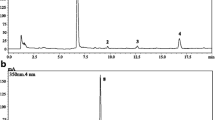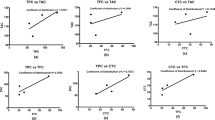Abstract
Erodium glaucophyllum, Erodium hirtum and Erodium guttatum were medicinal herbs from a southern Mediterranean known for its health benefits. There is a strong demand for the find of new anti-pathogenic bacteria metabolites. In the present study, the different ethanolic extracts of leaves, flowers, and Roots from the three plants were evaluated. The phenolics contents (total phenolic content, total flavonoids, and condensed tannins), antioxidant potentials, and in microbiological media to determine their effects on bacteria (Escherichia coli K12, pseudomonas aeruginosa DSM1128, Staphylococcus aureus 29213 ATCC, Enterococcus aerogenes 13048 ATCC, Enterococcus faecalis 40589, and Proteus mirabilis 3128) were investigated. The results showed that, the different extracts of the three species exhibited high content in polyphenols, flavonoids, and tannins. The leaves extract of Erodium glaucophyllum has the highest levels of polyphenols, flavonoids, and tannins; 154.2 ± 0.5 µg GAE/g DR, 68.2 ± 3.6 µg RE/g DR, and 36.2 ± 1.4 µg CE/g DR, respectively. In addition, the leaves extract of Erodium glaucophyllum possesses highest antioxidant activities (totals antioxidant capacity, 2,2-diphenyl-1-picrylhydrazyl (DPPH)) to compare with the other extracts. Furthermore, the three medicinal plants exhibited a high antimicrobial potential against pathogenic bacteria. The maximum inhibition showed in the Erodium glaucophyllum leaves extract against Enterococcus aerogenes 13048 ATCC, pseudomonas aeruginosa DSM1128, and Proteus mirabilis 3128. A significant positive correlation was found between the polyphenols content, antioxidant activity and antimicrobial activity of the different extracts.

Similar content being viewed by others
REFERENCES
Aboaba, O.O. and Efuwape, B.M., Antibacterial properties of some Nigerian species, Biol. Res. Commun., 2001, vol. 13, pp. 183–188.
Akaydin, G., Şimşek, I., Arituluk, Z.C., and Yeşilada, E., An ethnobotanical survey in selected towns of the Mediterranean subregion (Turkey), Turk. J. Biol., 2013, vol. 37, no 2, pp. 230–247. https://doi.org/10.3906/biy-1010-139
Bremner, P., Rivera, D., Calzado, M.A., Obón, C., Inocencio, C., Beckwith, C., and Heinrich, M., Assessing medicinal plants from South-Eastern Spain for potential anti-inflammatory effects targeting nuclear factor-Kappa B and other pro-inflammatory mediators, J. Ethnopharmacol., 2009, vol. 124, no 2, pp. 295–305. https://doi.org/10.1016/j.jep.2009.04.035
Celiktas, O.Y., Kocabas, E.H., Bedir, E., Sukan, F.V., Ozek, T., and Baser, K.H.C., Antimicrobial activities of methanol extracts and essential oils of Rosmarinus officinalis, depending on location and seasonal variations, Food Chem., 2007, vol. 100, no 2, pp. 553–559. https://doi.org/10.1016/j.foodchem.2005.10.011
Dutt, H. C., Bhagat, N., and Pandita, S., Oral traditional knowledge on medicinal plants in jeopardy among Gaddi shepherds in hills of northwestern Himalaya, J&K, India, J. Ethnopharmacol., 2015, vol. 168, pp. 337–348. https://doi.org/10.1016/j.jep.2015.03.076
Esmaeili, S., Naghibi, F., Mosaddegh, M., Sahranavard, S., Ghafari, S., and Abdullah, N.R., Screening of antiplasmodial properties among some traditionally used Iranian plants, J. Ethnopharmacol., 2009, vol. 121, no. 3, pp. 400–404. https://doi.org/10.1016/j.jep.2008.10.041
Fiz, O., Vargas, P., Alarcón, M. L., and Aldasoro, J. J., Phylogenetic relationships and evolution in Erodium (Geraniaceae) based on trnL-trnF sequences, Syst. Bot., 2006, vol. 31, no. 4, pp. 739–763. https://doi.org/10.1600/036364406779695906
Fiz-Palacios, O., Vargas, P., Vila, R., Papadopulos, A.S.T., and Aldasoro, J.J., The uneven phylogeny and biogeography of Erodium (Geraniaceae): radiations in the Mediterranean and recent recurrent intercontinental colonization, Ann. Bot., 2010, vol. 106, no. 6, pp. 871–884. https://doi.org/10.1093/aob/mcq184
Hamza, G., Emna, B.H., Yeddes, W., Dhouafli, Z., Moufida, T.S., and El Akrem, H., Chemical composition, antimicrobial and antioxidant activities data of three plants from Tunisia region: Erodium glaucophyllum, Erodium hirtum and Erodium guttatum, Data Brief, 2018, vol. 19, pp. 2352–2355. https://doi.org/10.1016/j.dib.2018.07.005
Kang, C.I., Kim, S.H., Bang, J.W., Kim, H.B., Kim, N.J., Kim, E.C., and Choe, K.W., Community-acquired versus nosocomial Klebsiella pneumoniae bacteremia: clinical features, treatment outcomes, and clinical implication of antimicrobial resistance, J. Korean Med. Sci., 2006, vol. 21, no 5, p. 816. https://doi.org/10.3346/jkms.2006.21.5.816
Munekata, P. E., Alcántara, C., Collado, M. C., Garcia-Perez, J. V., Saraiva, J. A., Lopes, R. P., and Lorenzo, J. M., Ethnopharmacology, phytochemistry and biological activity of Erodium species: a review, Food Res. Int., 2019, vol. 126, p. 108659. https://doi.org/10.1016/j.foodres.2019.108659
Nikitina, V. S., Kuz’mina, L.Y., Melent’ev, A.I., and Shendel, G.V., Antibacterial activity of polyphenolic compounds isolated from plants of Geraniaceae and Rosaceae families, Appl. Biochem. Microbiol., 2007, vol. 43, no. 6, pp. 629–634. https://doi.org/10.1134/S0003683807060117
Serafini, M., Bellocco, R., Wolk, A., and Ekstrom, A. M., Total antioxidant potential of fruit and vegetables and risk of gastric cancer, Gastroenterology, 2002, vol. 123, no. 4, pp. 985–991. https://doi.org/10.1053/gast.2002.35957
Tlili, N., Elfalleh, W., Hannachi, H., Yahia, Y., Khaldi, A., Ferchichi, A., and Nasri, N., Screening of natural antioxidants from selected medicinal plants, Int. J. Food Prop., 2013, vol. 16, no 5, pp. 1117–1126. https://doi.org/10.1080/10942912.2011.576360
Velioglu, Y., Mazza, G., Gao, L., and Oomah, B. D., Antioxidant activity and total phenolics in selected fruits, vegetables, and grain products, J. Agricult. Food Chem., 1998, vol. 46, no 10, pp. 4113–4117. https://doi.org/10.1021/jf9801973
Zhang, Y., Li, S., and Tian, Z., Morphological and histological studies of the Chinese drug lao-guan-cao, Acta Pharm. Sin., 1995, vol. 30, no 1, p. 46–58. PMID: 7660787
Funding
This study supported by University of Tunis EL Manar, University of Applied Sciences, Neubrandenburg, Germany, for the infrastructure and facilities, and Laboratory of Aromatic and Medicinal Plants, Center of Biotechnology (LR15CBBC06) at the Ecopark of Borj-cédria. BP-901, 2050 Hammam-Lif. Tunisia.
Author information
Authors and Affiliations
Corresponding author
Ethics declarations
The authors declare that they have no conflict of interest. This article does not contain any studies involving animals or human participants performed by any of the authors.
Rights and permissions
About this article
Cite this article
Hamza Gadhoumi, Martinez-Rojas, E., Tounsi, M.S. et al. Phenolics Composition and Biological Activities Assessment of Leaves, Flowers and Roots Extracts from Erodium glaucophyllum, Erodium hirtum and Erodium guttatum. Biol Bull Russ Acad Sci 48, 667–672 (2021). https://doi.org/10.1134/S1062359021060091
Received:
Revised:
Accepted:
Published:
Issue Date:
DOI: https://doi.org/10.1134/S1062359021060091




